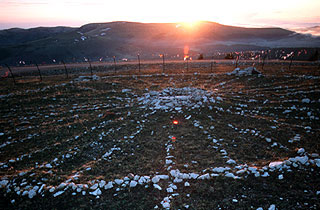 Bighorn Medicine Wheel
Bighorn Medicine Wheel
On top of the Bighorn Range in Wyoming, a desolate 9,642 feet high and only
reachable during the warm summer months, lies an ancient Native American
construction -- an 80' diameter wheel-like pattern
made of stones. At the center
of the circle is a doughnut-shaped pile of stones, a cairn,
connected to the rim by 28 spoke-like lines of stones.
Six more stone cairns are arranged around the circle, most large enough
to hold a sitting human.
The central cairn is about 12 feet in diameter and 2' high.
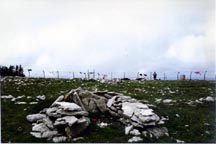
|
The Medicine Wheel is located in the Bighorn Mountains in
Wyoming, USA, off highway 14A. Elevation: 9,642 feet.
Latitude: 44 degrees 49' 32" N.; longitude: 107 degrees 55' 15" W.
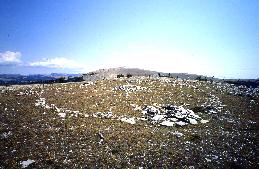
|
| If you stand or sit at one cairn looking towards another, you will be
pointed to certain places on the distant horizon.
These points indicate where the Sun rises
or sets on summer solstice and where certain important stars
rise heliacally, that is, first rise at dawn after being behind
the Sun.
The dawn stars helped foretell when the Sun ceremonial
days would be coming.
The area is free of snow only for 2 months -- around the summer
solstice. |
The wheel has 28 spokes, the same number used in the roofs of ceremonial
buildings such as the Lakota Sundance lodge. These
always includes an entrance to the east, facing the rising Sun,
and include 28 rafters for the 28 days in the lunar cycle.
The number 28 is sacred to some of the Indian tribes because of
its significance as the lunar month.
In Bighorn's case, could the special number 28 also refer to the
helicial or dawn rising of Rigel 28 days past the Solstice, and Sirius
another 28 past that? (More below.)
|
|
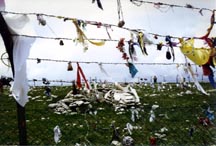
Prayer offerings are left at Medicine Wheel, even now.
|
Construction:
The wheel was constructed by Plains Indians between 300-800 years ago,
and has been used and maintained by various groups since then.
The central cairn is the oldest part,
with excavations showing it extends below the wheel and has been buried
by wind-blown dust.
It may have supported a central pole.
The star alignments are most accurate for around 1200 AD, since slight
changes in the Earth's orbit have caused perturbations since.
The solstice alignments remain accurate today.
The Bighorn wheel is part of a much larger complex of interrelated
archeological sites that represent 7000 years of Native American adaptation
to and use of the alpine landscape that surrounds Medicine Mountain.
Numerous contemporary American Indian traditional use
ceremonial staging areas, medicinal and ceremonial plant gathering areas, sweat
lodge sites, altars offering locales and fasting (vision quest) enclosures, can
be found nearby. Ethnohistoric, ethnographic, and archeological evidence
demonstrates that the Medicine Wheel and the surrounding landscape constitute one
of the most important and well preserved ancient Native American sacred site
complexes in North America.
Between 70 and 150 wheels have been
identified in South Dakota, Wyoming, Montana, Alberta, and Saskatchewan.
Astronomical Alignments:
In 1974, an archaeoastronomer named Jack Eddy visited this Medicine Wheel and
studied its alignments, that is, its arrangements of rocks, cairns, and
spokes. He found the arrangements point to the rising and setting places of
the Sun at summer solstice, as well as the rising places of Aldebaran in
Taurus, Rigel in Orion, and Sirius in Canis Major -- all bright, important
stars associated with the Solstice. Later another astronomer, Jack
Robinson, found a cairn pair that
marked the bright star Fomalhaut's rising point with the Sun
28 days before solstice.
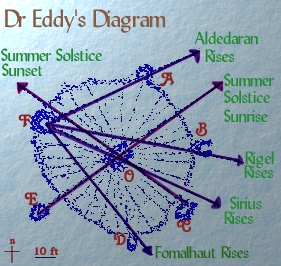 |
Sighting from cairn E through the center hub (which may have supported
a pole) marks the summer solstice sunrise.
Sighting from C through the center marked the equivalent solstice sunset.
Standing at cairn F, one could sight the once-yearly dawn,
or heliacal,
risings of the key stars
Aldebaran, Rigel, and Sirius, which play symbolic roles in an ancient
Cheyenne Massaum ceremony
and are also important stars in the sacred Lakota circle constellation
"The Animal".
|
The dawn or heliacal rising of a star is important because it pinpoints
a date exactly. This is the day a star is first seen, just before dawn,
after it has been behind the Sun for an entire season.
From about 1200 AD to 1700 AD, these 4 stars would have acted as
solstice markers for the Native Americans -
Fomalhaut (F to D) would rise 28 days before the Summer Solstice,
Aldebaran (F to A) would rise during the 2 days just before
the solstice,
Rigel (F to B) would rise 28 days after the solstice,
and Sirius (F to C) 28 days after that,
at the end of August and hence marking the end
of summer and time to leave the mountain.
For more details on the astronomical alignments, see
Petroform Astronomy.
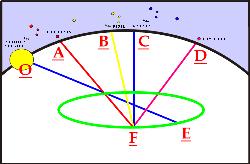
Image Credits:
- Banner by Troy Cline, GSFC.
- Medicine Wheel sunset photograph by Tom Melham.
- Keyhole video developed by Professor Philip Scherrer.
Keyhole2 PRO, movie maker, data importer, and high sppeed printer
modules provided thanks to Jack Veenstra and Dennis Reinhardt of
Keyhole-Google.
- Medicine Wheel color photo by
Richard Collier, Wyoming State Historic Preservation Office.
Used with permission.
- Cairn and prayer offerings photos by Deborah Scherrer.
- Map and photographic views by Steven Dutch, Natural and Applied Sciences, University of Wisconsin - Green Bay
- Satellite photo from TerraServer USA
- From original diagram by Jack Eddy
- Alignment diagram copyright (c) 2002 by Boissevain Community Archives
and Moncur Gallery. All Rights Reserved.
©2008-2023 by Stanford SOLAR Center | Permitted Uses | Credits
|

